March of Trade's Harmonious Shades
Posted November 2012 in Advertising, History of Photography, Journals, Publishing
The Photographic Times (1871-1915) was one of America’s earliest and most important photographic journals. By 1880, its publisher declared it the highest circulating magazine of its type in the country and by December of 1893, the first edition was stated to be 5,000 copies a week, an extraordinary number considering the inclusion by that time of a hand-pulled photogravure or collotype frontis plate. As a researcher, it would be presumptuous of me to think it possible in the modern day to present a fully-formed history of this publication without more direct corroboration from those who made that history. But since those folks are all dead, someone had to take a stab at it.
 1871-1873: The Photographic Times was first published by The Scovill Manufacturing Company, which maintained offices in this building at 36 Park Row and 4 Beekman streets in lower Manhattan. Completed in 1857 and known as the Potter or World Building, it was the home of the New York World newspaper offices and many other publications. (an adjoining building for The New York Times is at far left of frame) The sign for the Scovill Manufacturing Co. has been highlighted in red for clarity on the Park Row side. Since rebuilt, this building and block was destroyed by a massive fire on January 31, 1882 that claimed 12 lives. This detail from a circa 1870 stereoscopic view in the collection of the New York Public Library: Image ID: G91F211_034F
1871-1873: The Photographic Times was first published by The Scovill Manufacturing Company, which maintained offices in this building at 36 Park Row and 4 Beekman streets in lower Manhattan. Completed in 1857 and known as the Potter or World Building, it was the home of the New York World newspaper offices and many other publications. (an adjoining building for The New York Times is at far left of frame) The sign for the Scovill Manufacturing Co. has been highlighted in red for clarity on the Park Row side. Since rebuilt, this building and block was destroyed by a massive fire on January 31, 1882 that claimed 12 lives. This detail from a circa 1870 stereoscopic view in the collection of the New York Public Library: Image ID: G91F211_034F
Besides the written record, the important legacy left by the journal in my estimation are its hand-pulled photogravure plates which appeared regularly from 1889-1904, the latter being included in the combined but short-lived publication The Photographic Times-Bulletin. As a collector of this material for many years, it is surprising to me how little seems to have survived given the large circulation of the Times. My overview of the publication, which appears here in PhotoSeed Highlights, might very well put you to sleep due to length, or perhaps not. In tracing the history of this journal, my journey of discovery made me realize a fact of interest to all photographers, especially with respect to the United States: the first publisher of the Times, the Scovill Manufacturing Company of New York City, with a large factory complex in Waterbury, CT, was largely responsible for the birth and progress of photographic commerce in 19th century America.
 1871-1915 timeline: The Scovill company, publishers of The Photographic Times, did business at 9 different locations in New York City over 45 years. This Google street map with inset address key covers a walking distance today of approximately 4.6 miles. Arranged chronologically from A-I, the dates and addresses for the company are as follows: 1871-1873: 4 Beekman Street 1874-1884: 419-421 Broome Street 1884-1895: 423 Broome Street 1896-1900: 60-62 East 11th Street 1900 (Fall)-1902: 3-5 West 19th Street April 1902-1903: 122-124 Fifth Ave. 1904: 75-77 Eighth Ave. December, 1904-1908: 39 Union Square West 1909-1915: 135 West 14th Street
1871-1915 timeline: The Scovill company, publishers of The Photographic Times, did business at 9 different locations in New York City over 45 years. This Google street map with inset address key covers a walking distance today of approximately 4.6 miles. Arranged chronologically from A-I, the dates and addresses for the company are as follows: 1871-1873: 4 Beekman Street 1874-1884: 419-421 Broome Street 1884-1895: 423 Broome Street 1896-1900: 60-62 East 11th Street 1900 (Fall)-1902: 3-5 West 19th Street April 1902-1903: 122-124 Fifth Ave. 1904: 75-77 Eighth Ave. December, 1904-1908: 39 Union Square West 1909-1915: 135 West 14th Street
The following visual timeline is my attempt to show off the look of the publication over the 45 years it existed under its own imprint along with the principal men involved in editing it- part of the Photographic Times Publishing Association, one of the many business interests of the parent company. During this time, Scovill’s march of trade on the island of Manhattan involved eight separate business moves over a walkable distance today of roughly 4.6 miles. To this end, part of the mission statement issued by the Time’s editors to its many readers- from post American Civil War beginnings in January, 1871 to its 1915 demise remained true over the life of the journal:
we shall intersperse here and there delicate half-tones and harmonious shades from sources of information which shall do you good service in your manipulations, and add to your store of useful knowledge. We have engaged talent for this end, which is competent and able to instruct.
-David Spencer November, 2012
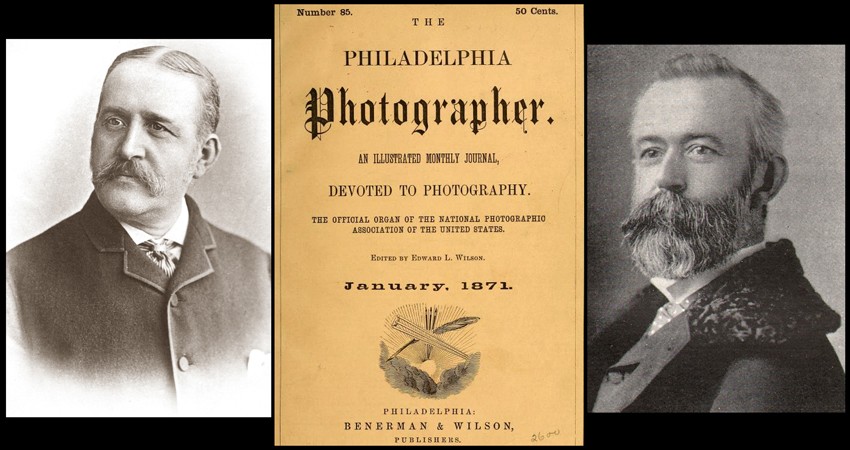 1870: The Times first appeared as a supplement incorporated within the pages of the monthly Philadelphia Photographer, center, one of the first journals devoted to photography published in America beginning in 1864. Washington Irving Adams, left, (1832-1896) came up with the idea for the Times during a working lunch attended in 1869 by men associated with the Scovill Manufacturing Company. Edward Wilson, right, (1838-1903) was the founder, editor and publisher of the Philadelphia Photographer, as well as good friend to Adams. Photo credits: portraits: PhotoSeed Archive; magazine cover: HathiTrust
1870: The Times first appeared as a supplement incorporated within the pages of the monthly Philadelphia Photographer, center, one of the first journals devoted to photography published in America beginning in 1864. Washington Irving Adams, left, (1832-1896) came up with the idea for the Times during a working lunch attended in 1869 by men associated with the Scovill Manufacturing Company. Edward Wilson, right, (1838-1903) was the founder, editor and publisher of the Philadelphia Photographer, as well as good friend to Adams. Photo credits: portraits: PhotoSeed Archive; magazine cover: HathiTrust
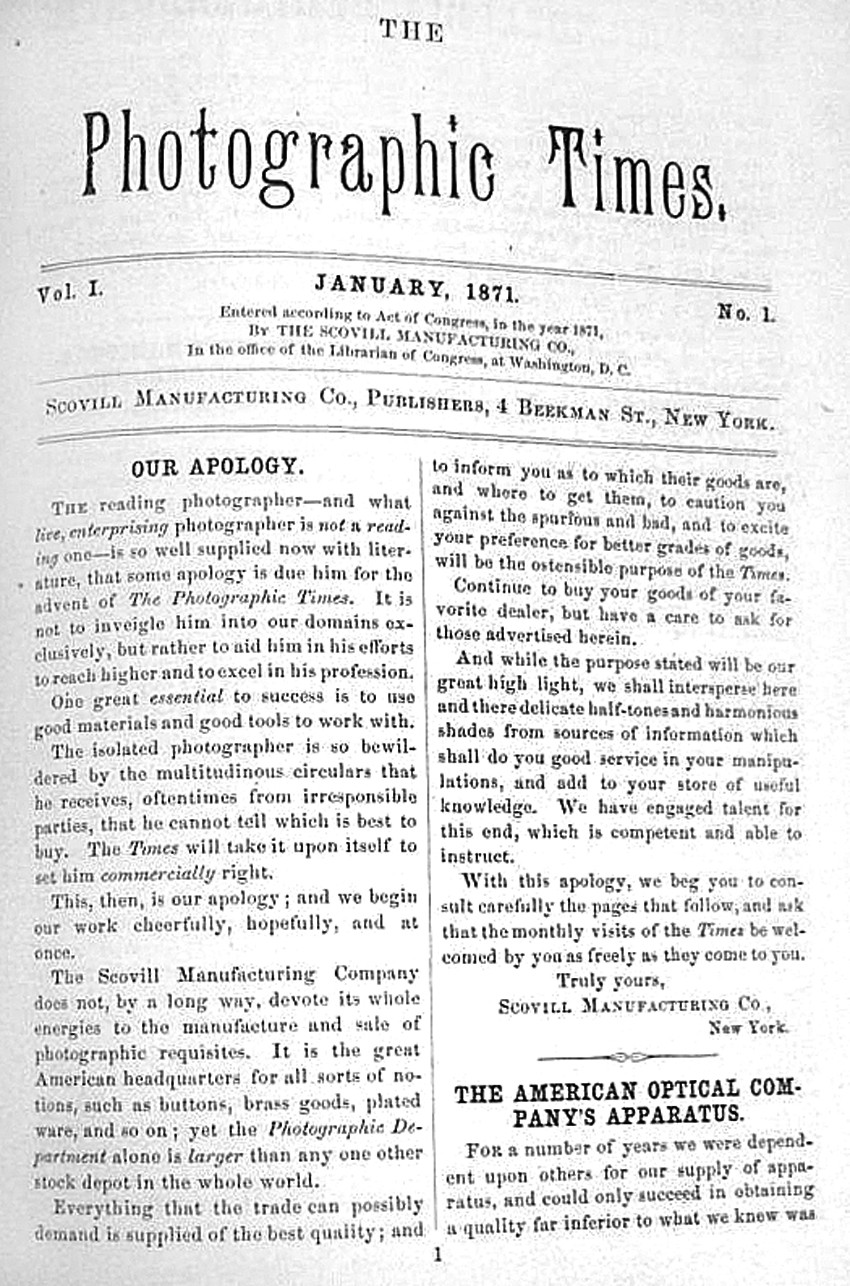 1871: The Photographic Times appeared for the first time under the imprint of the Scovill Manufacturing Company of 4 Beekman street in New York City beginning with the January, 1871 issue. The first page of the eight-page trade monthly included an "Apology", intended to "set the photographer commercially right.” It was sent out free of charge with Wilson's Philadelphia Photographer, The Photographic World, and Walzl’s Photographic Magazine, along with an additional 500 copies mailed each month from Scovill's New York offices. Photo credit: D. Richards, Bookman: Pittsburgh, PA
1871: The Photographic Times appeared for the first time under the imprint of the Scovill Manufacturing Company of 4 Beekman street in New York City beginning with the January, 1871 issue. The first page of the eight-page trade monthly included an "Apology", intended to "set the photographer commercially right.” It was sent out free of charge with Wilson's Philadelphia Photographer, The Photographic World, and Walzl’s Photographic Magazine, along with an additional 500 copies mailed each month from Scovill's New York offices. Photo credit: D. Richards, Bookman: Pittsburgh, PA
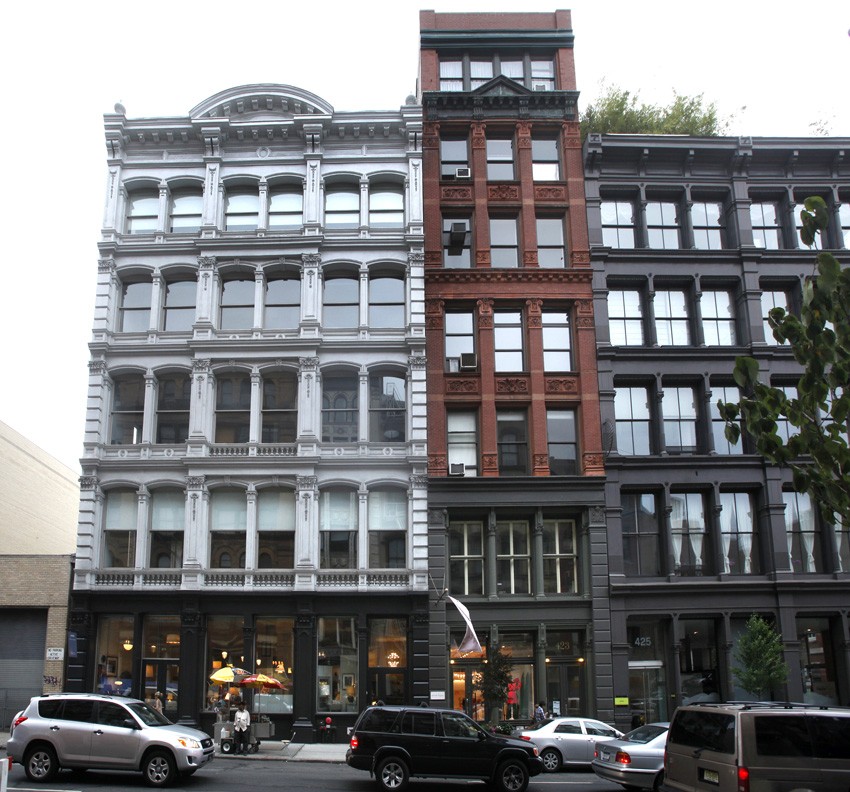 1874 | 1884: Because of "want of room and the march of trade", the Scovill company had moved to new quarters at 419-421 Broome street by January, 1874. Located in SoHo, the building as it stands today can be seen at left in a photograph taken in June, 2012. By May of 1884, another move for the Times and the Scovill company took place right next door: the building at center with the address of 423 Broome Street, built for the company by architectural firm D. & J. Jardine. Described as a warehouse building at the time, Times editor Washington Irving Adams commented on its many benefits: "This well appointed structure, embracing seven floors and a double basement, we have erected to meet the special requirements of our business. The building, with its improved interior arrangements, will greatly enlarge our facilities and enable us to respond to the wants of our patrons in a more expeditious and satisfactory manner than heretofore. For the accommodation of our friends, a well-constructed dark-room and sky-light have been added to the many other conveniences introduced, all of which will subserve in various ways the interests of our customers." PhotoSeed Archive photograph by David Spencer
1874 | 1884: Because of "want of room and the march of trade", the Scovill company had moved to new quarters at 419-421 Broome street by January, 1874. Located in SoHo, the building as it stands today can be seen at left in a photograph taken in June, 2012. By May of 1884, another move for the Times and the Scovill company took place right next door: the building at center with the address of 423 Broome Street, built for the company by architectural firm D. & J. Jardine. Described as a warehouse building at the time, Times editor Washington Irving Adams commented on its many benefits: "This well appointed structure, embracing seven floors and a double basement, we have erected to meet the special requirements of our business. The building, with its improved interior arrangements, will greatly enlarge our facilities and enable us to respond to the wants of our patrons in a more expeditious and satisfactory manner than heretofore. For the accommodation of our friends, a well-constructed dark-room and sky-light have been added to the many other conveniences introduced, all of which will subserve in various ways the interests of our customers." PhotoSeed Archive photograph by David Spencer
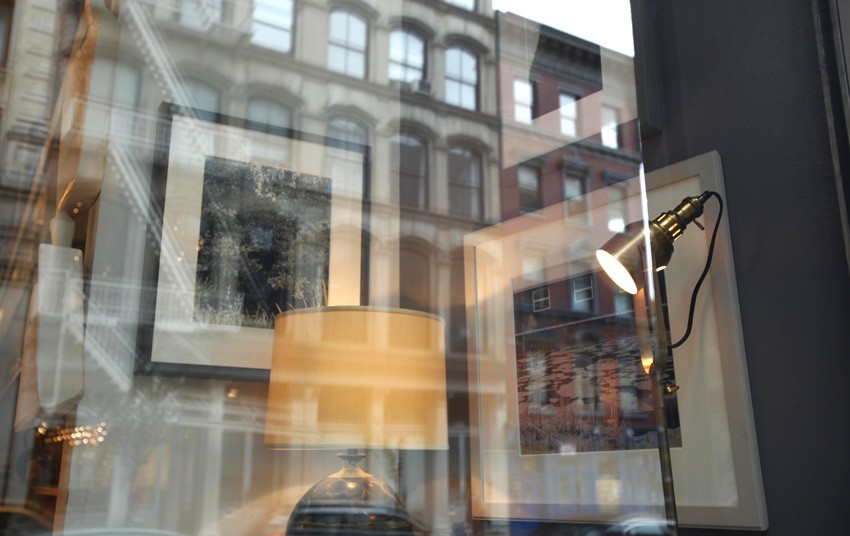 2012: Serendipity, coincidence or both? A modern day investigator peering through the front window of 419 Broome street is startled to learn the fine art of photography is alive and well nearly 140 years after this space occupied one of the leading mouthpieces of the photographic press. In the business space Aero LTD, a home furnishing store, professional photographer Michelle Arcila's work is framed and ready for sale. Her photographs "Present Tense" at left and "Olympia" share the reflected outside world of Broome street. PhotoSeed Archive photograph by David Spencer
2012: Serendipity, coincidence or both? A modern day investigator peering through the front window of 419 Broome street is startled to learn the fine art of photography is alive and well nearly 140 years after this space occupied one of the leading mouthpieces of the photographic press. In the business space Aero LTD, a home furnishing store, professional photographer Michelle Arcila's work is framed and ready for sale. Her photographs "Present Tense" at left and "Olympia" share the reflected outside world of Broome street. PhotoSeed Archive photograph by David Spencer
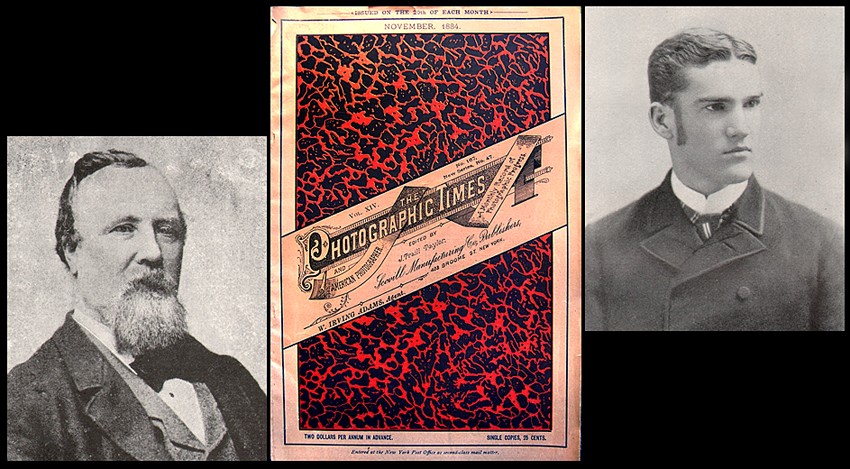 1881 | 1884 | 1885: Beginning in 1881, a new editorial direction was brought to the Times, renamed The Photographic Times and American Photographer, by Englishman John Traill Taylor, (1827-1895) left. A veteran of the British Journal of Photography, he was eventually succeeded as editor by Washington Irving Lincoln Adams, (1865-1946) right, son of the journal's founder, joining the editorial staff in 1885. At center is a rare surviving example of a Times cover from November, 1884. Photo credits: portraits: PhotoSeed Archive; magazine cover: Ebay
1881 | 1884 | 1885: Beginning in 1881, a new editorial direction was brought to the Times, renamed The Photographic Times and American Photographer, by Englishman John Traill Taylor, (1827-1895) left. A veteran of the British Journal of Photography, he was eventually succeeded as editor by Washington Irving Lincoln Adams, (1865-1946) right, son of the journal's founder, joining the editorial staff in 1885. At center is a rare surviving example of a Times cover from November, 1884. Photo credits: portraits: PhotoSeed Archive; magazine cover: Ebay
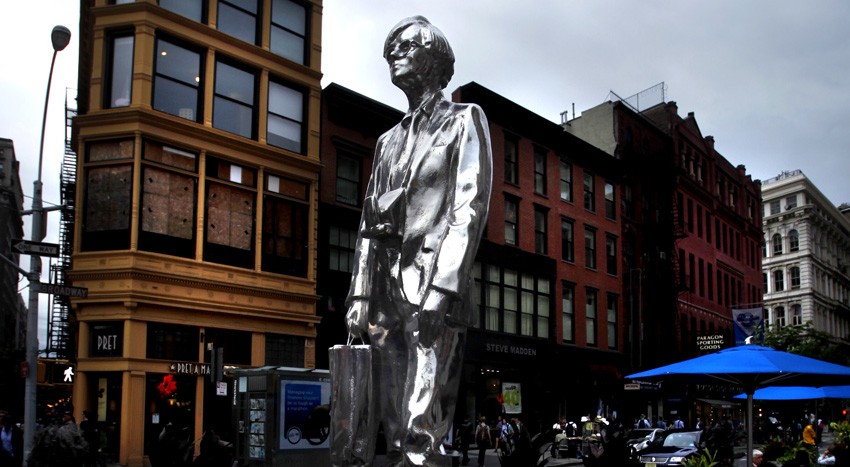 2012: Besides being the king of Pop art, Andy Warhol (1928-1987) was also a passionate photographer, going everywhere with his Polaroid camera-seen here around his neck in the famous (since removed) chrome-plated "Andy Monument" by sculptor Rob Pruitt in Union Square. A parallel or association with the Photographic Times? You bet. Albeit sixty years later, Warhol’s second "Silver Factory" was established in 1968 and located around the corner from the statue at 33 Union Square West, just three doors down from 39 Union Square, one of the last home offices for the Times from 1904-1908. PhotoSeed Archive photograph (June) by David Spencer
2012: Besides being the king of Pop art, Andy Warhol (1928-1987) was also a passionate photographer, going everywhere with his Polaroid camera-seen here around his neck in the famous (since removed) chrome-plated "Andy Monument" by sculptor Rob Pruitt in Union Square. A parallel or association with the Photographic Times? You bet. Albeit sixty years later, Warhol’s second "Silver Factory" was established in 1968 and located around the corner from the statue at 33 Union Square West, just three doors down from 39 Union Square, one of the last home offices for the Times from 1904-1908. PhotoSeed Archive photograph (June) by David Spencer
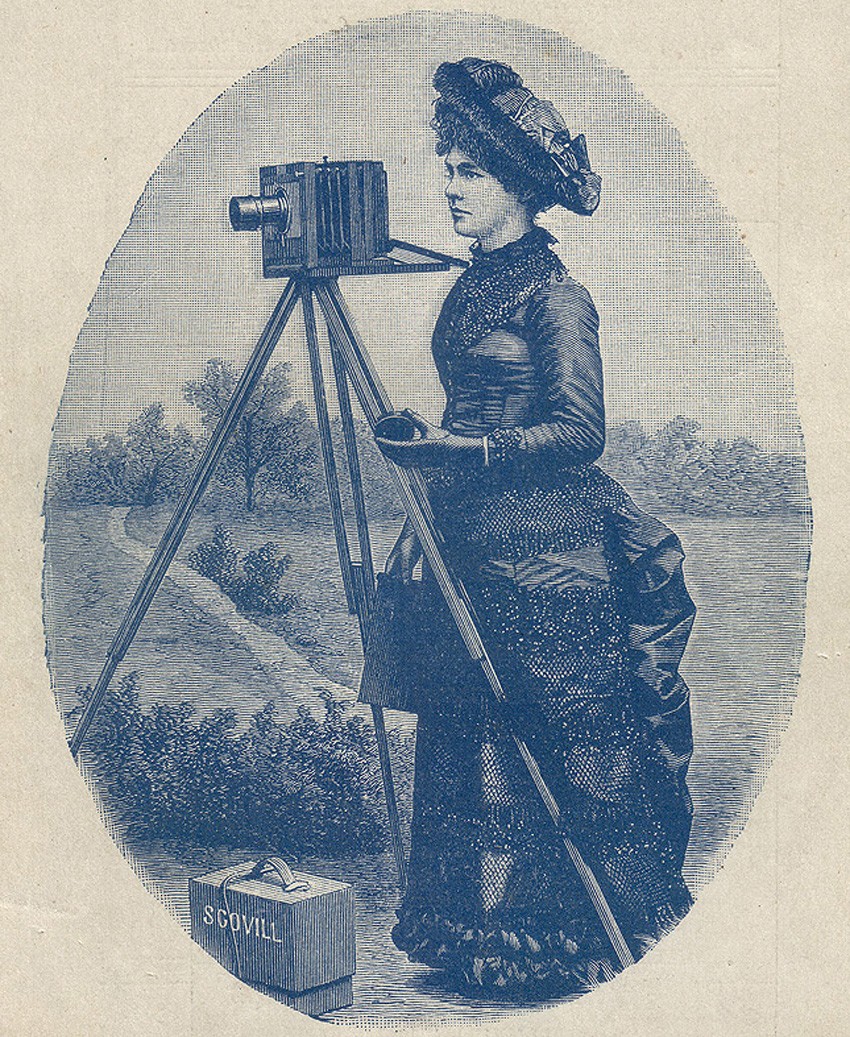 1883: With modern dry gelatin photographic plates replacing the cumbersome wet plate (collodion) process around 1881, the Scovill company through their publications including the Photographic Times began marketing in earnest complete and affordable amateur outfits to the masses. This fashionably dressed lady amateur, appearing as early as 1883 as a wood engraving in Scovill's catalogue: "How to Make Photographs", advertised their "Amateur Photographic Requisites". For the grand sum of $10.00, a photographer could obtain "Favorite Outfit A": an adjustable 4 x 5 Scovill plate camera, "Waterbury" achromatic nickel plated lens, a Taylor folding tripod, a double dry plate holder for the camera and carrying case. After becoming the Scovill & Adams company in 1889, the firm developed other popular mass market cameras including the Henry Clay and Solograph models as well as many others. 1889 engraving from Scovill catalogue courtesy of Larry Pierce.
1883: With modern dry gelatin photographic plates replacing the cumbersome wet plate (collodion) process around 1881, the Scovill company through their publications including the Photographic Times began marketing in earnest complete and affordable amateur outfits to the masses. This fashionably dressed lady amateur, appearing as early as 1883 as a wood engraving in Scovill's catalogue: "How to Make Photographs", advertised their "Amateur Photographic Requisites". For the grand sum of $10.00, a photographer could obtain "Favorite Outfit A": an adjustable 4 x 5 Scovill plate camera, "Waterbury" achromatic nickel plated lens, a Taylor folding tripod, a double dry plate holder for the camera and carrying case. After becoming the Scovill & Adams company in 1889, the firm developed other popular mass market cameras including the Henry Clay and Solograph models as well as many others. 1889 engraving from Scovill catalogue courtesy of Larry Pierce.
 1886: Dr. Charles Ehrmann, (1822-1894) a pharmaceutical chemist by training at the University of Berlin, joined the Photographic Times as an assistant editor under John Traill Taylor beginning in 1881. His obituary penned by Frederick Beach in the American Amateur Photographer said he became the "guiding editorial spirit" for the Times after Taylor's retirement in 1886, even under Lincoln Adams, and was the journal's "chief experimentalist- investigating and writing in the pages of the Times the myriad processes then used in traditional wet darkroom photography. In the Fall of 1886, Ehrmann was named instructor in the newly established Chautauqua University School of Photography, chiefly a correspondence school, but also one where he gave hands-on instruction in photography with diplomas awarded from the summer home in upstate New York as well as the Broome street offices of the Times. This photograph of Ehrmann appeared as a full-page plate in the May 25, 1888 issue of the Times. Photo credit: HathiTrust
1886: Dr. Charles Ehrmann, (1822-1894) a pharmaceutical chemist by training at the University of Berlin, joined the Photographic Times as an assistant editor under John Traill Taylor beginning in 1881. His obituary penned by Frederick Beach in the American Amateur Photographer said he became the "guiding editorial spirit" for the Times after Taylor's retirement in 1886, even under Lincoln Adams, and was the journal's "chief experimentalist- investigating and writing in the pages of the Times the myriad processes then used in traditional wet darkroom photography. In the Fall of 1886, Ehrmann was named instructor in the newly established Chautauqua University School of Photography, chiefly a correspondence school, but also one where he gave hands-on instruction in photography with diplomas awarded from the summer home in upstate New York as well as the Broome street offices of the Times. This photograph of Ehrmann appeared as a full-page plate in the May 25, 1888 issue of the Times. Photo credit: HathiTrust
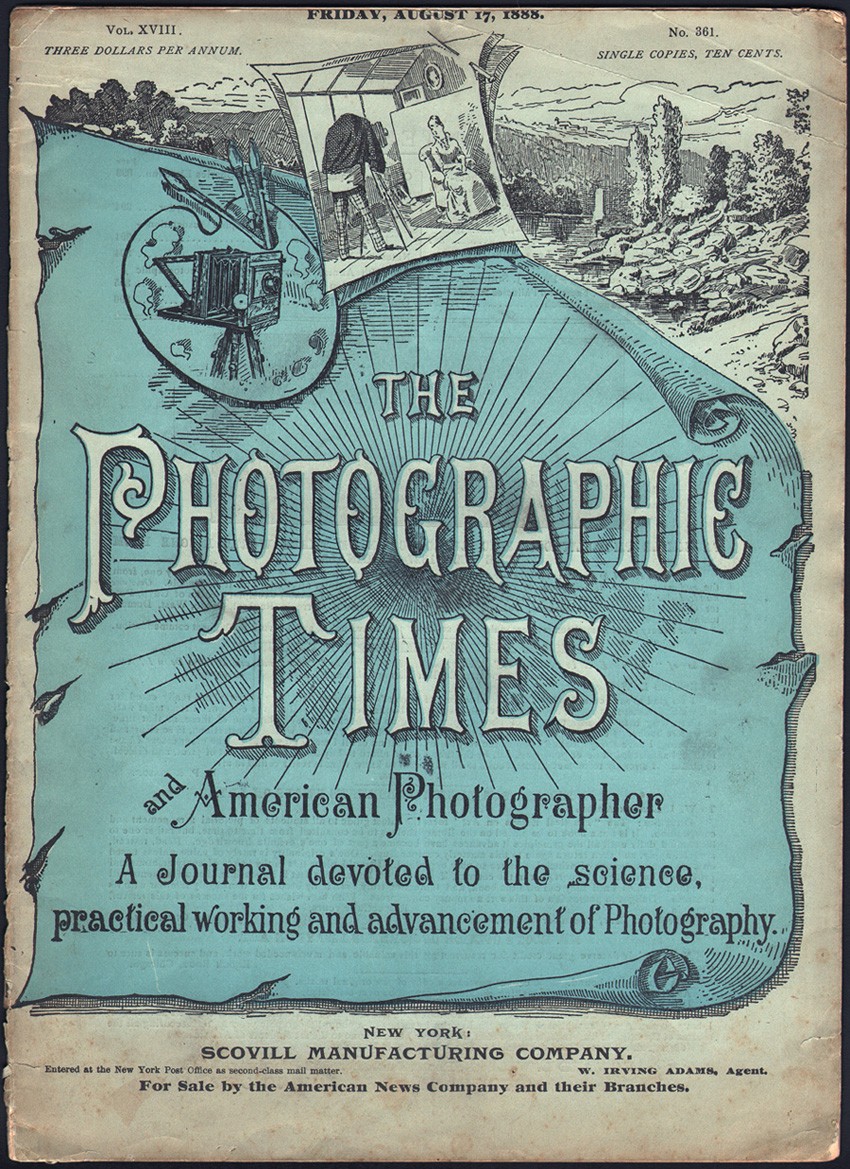 1887-1888: This is an example of a cover from The Photographic Times and American Photographer dated Friday, August 17, 1888. This was the same design used for the journal in 1887. (unknown if it was used before 1887) The quarto format journal was printed in blue and black with the artwork possibly being by the hand of Brooklyn artist William Mozart. From: PhotoSeed Archive
1887-1888: This is an example of a cover from The Photographic Times and American Photographer dated Friday, August 17, 1888. This was the same design used for the journal in 1887. (unknown if it was used before 1887) The quarto format journal was printed in blue and black with the artwork possibly being by the hand of Brooklyn artist William Mozart. From: PhotoSeed Archive
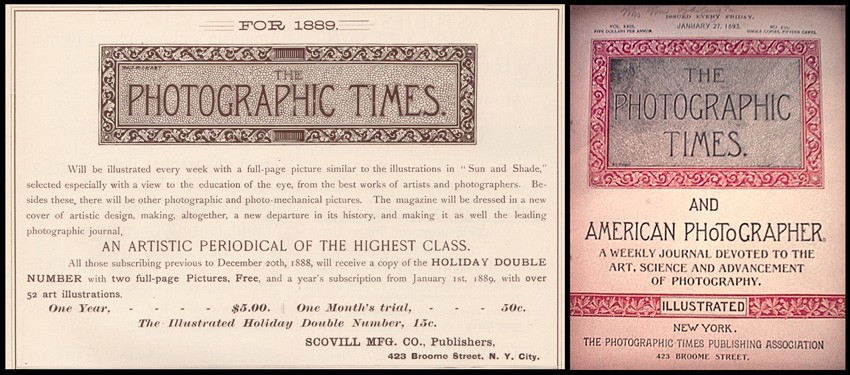 1889: This year brought a complete redesign to the look of the Times. Brooklyn artist and photographer William J. Mozart, (b. 1855) who had honed his skill first as a scene painter at a Boston museum beginning in 1878 came up with the logo seen here at left, incorporated within a January, 1889 advertisement for the Times in the periodical Sun and Shade. "The magazine will be dressed in a new cover of artistic design, making, altogether, a new departure in its history, and making it as well the leading photographic journal." The weekly would also for the first time feature in every issue a full-page illustration, typically a photogravure or fine process collotype. At right is an example of the new cover by Mozart. (this issue from January, 1893). Advertisement from PhotoSeed Archive; cover: Crown Antiques & Collectible
1889: This year brought a complete redesign to the look of the Times. Brooklyn artist and photographer William J. Mozart, (b. 1855) who had honed his skill first as a scene painter at a Boston museum beginning in 1878 came up with the logo seen here at left, incorporated within a January, 1889 advertisement for the Times in the periodical Sun and Shade. "The magazine will be dressed in a new cover of artistic design, making, altogether, a new departure in its history, and making it as well the leading photographic journal." The weekly would also for the first time feature in every issue a full-page illustration, typically a photogravure or fine process collotype. At right is an example of the new cover by Mozart. (this issue from January, 1893). Advertisement from PhotoSeed Archive; cover: Crown Antiques & Collectible
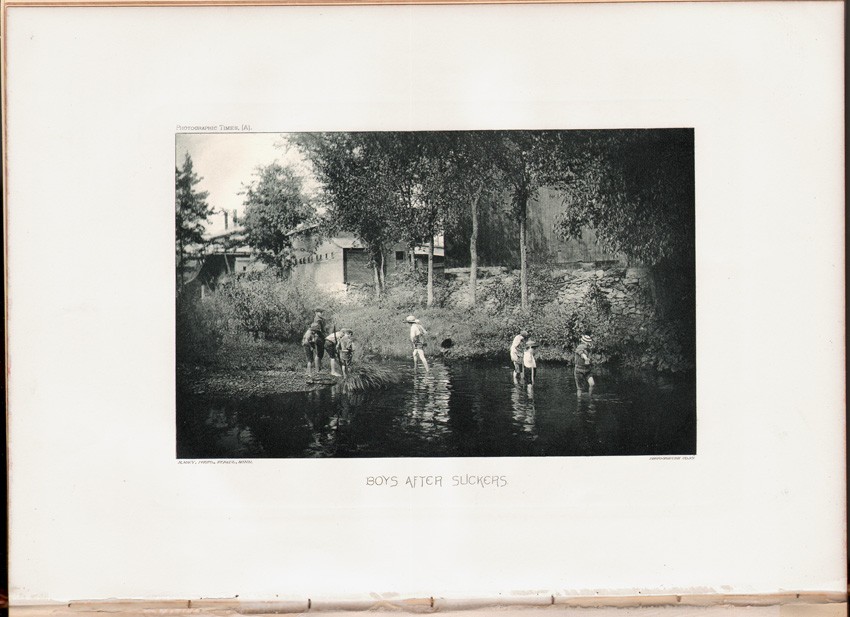 1889: "Boys after Suckers" by Minnesota photographer Rev. Herbert Macy, was the photogravure frontis plate for the April 18, 1890 weekly issue of the Times. Image: 11.2 x 17.9 cm | Support: 20.5 x 28.7 cm Photogravures such as these were a major selling point for potential subscribers, with the cost of a yearly subscription being $5.00. In 1893, the editors wrote: "The PHOTOGRAPHIC TIMES had frequently brought out full-page pictorial illustrations, in addition to the cuts and diagrams which always brightened its reading columns; but beginning with 1889, it presented its readers regularly, each week, with a full-page pictorial frontispiece, reproduced by photogravure or other high grade process, and including an occasional photographic print on albumen or other sensitive paper. It thus became the first and continues to be the only photographic weekly publication in the world, containing a full-page picture with every issue." Photo: PhotoSeed Archive
1889: "Boys after Suckers" by Minnesota photographer Rev. Herbert Macy, was the photogravure frontis plate for the April 18, 1890 weekly issue of the Times. Image: 11.2 x 17.9 cm | Support: 20.5 x 28.7 cm Photogravures such as these were a major selling point for potential subscribers, with the cost of a yearly subscription being $5.00. In 1893, the editors wrote: "The PHOTOGRAPHIC TIMES had frequently brought out full-page pictorial illustrations, in addition to the cuts and diagrams which always brightened its reading columns; but beginning with 1889, it presented its readers regularly, each week, with a full-page pictorial frontispiece, reproduced by photogravure or other high grade process, and including an occasional photographic print on albumen or other sensitive paper. It thus became the first and continues to be the only photographic weekly publication in the world, containing a full-page picture with every issue." Photo: PhotoSeed Archive
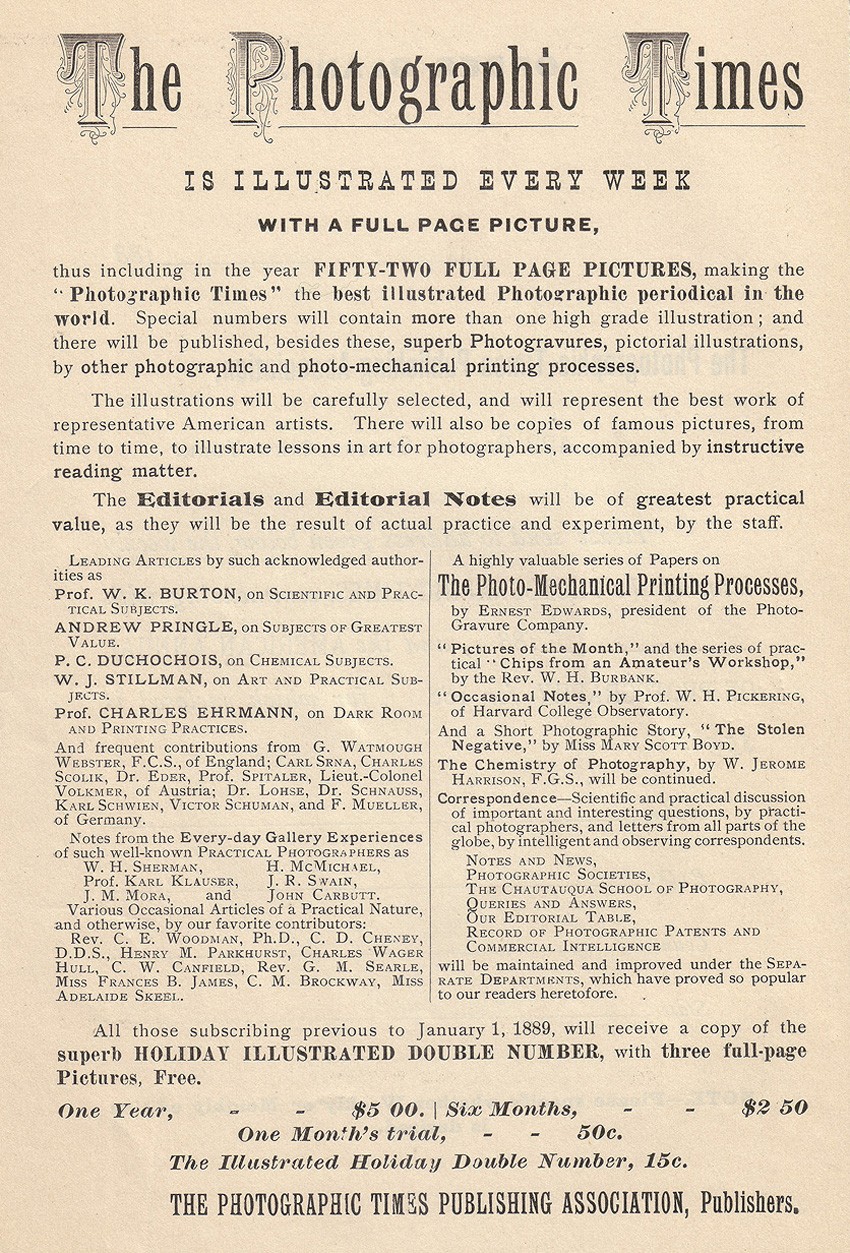 1889: With its new emphasis on high-grade illustrations that would be reproduced each week, other particulars and selling points, including the following quote, appeared in the 1889 Scovill & Adams company trade brochure "How to Make Photographs" : "The Editorials and Editorial Notes will be of greatest practical value, as they will be the result of actual practice and experiment, by the staff." Advertisement courtesy of Larry Pierce.
1889: With its new emphasis on high-grade illustrations that would be reproduced each week, other particulars and selling points, including the following quote, appeared in the 1889 Scovill & Adams company trade brochure "How to Make Photographs" : "The Editorials and Editorial Notes will be of greatest practical value, as they will be the result of actual practice and experiment, by the staff." Advertisement courtesy of Larry Pierce.
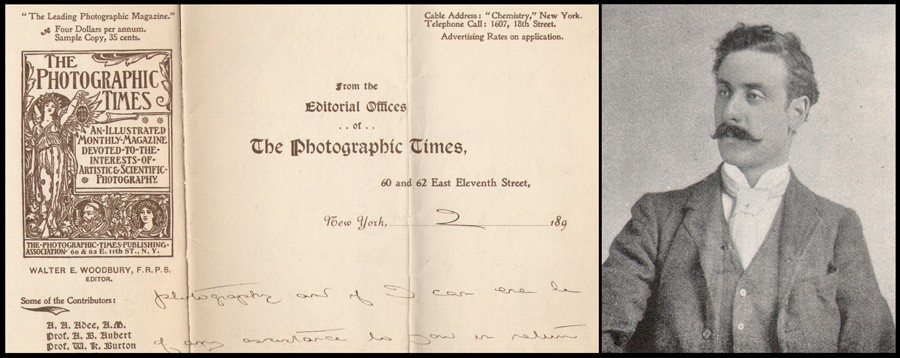 1893: In the Spring of this year, Walter Edward Woodbury, (1865-1905) seen at right around this time, joined the editorial staff of the Times, and before the end of 1894 was appointed editor by Lincoln Adams. A Fellow of the Royal Photographic Society and son of Englishman Walter Bentley Woodbury, (1834-1885) he oversaw major changes to the Times, including its transformation to a monthly and into a “high-class art magazine”. Perhaps the most noticeable change of this last aspect for a subscriber was the dramatic new cover design featuring Roman goddess Veritas holding out her lamp symbolically lighting the way for truth, designed by English bookplate artist George Richard Quested. The design was even incorporated into Woodbury's personalized Times letterhead, a detail of which can be seen here. Letterhead and portrait: PhotoSeed Archive
1893: In the Spring of this year, Walter Edward Woodbury, (1865-1905) seen at right around this time, joined the editorial staff of the Times, and before the end of 1894 was appointed editor by Lincoln Adams. A Fellow of the Royal Photographic Society and son of Englishman Walter Bentley Woodbury, (1834-1885) he oversaw major changes to the Times, including its transformation to a monthly and into a “high-class art magazine”. Perhaps the most noticeable change of this last aspect for a subscriber was the dramatic new cover design featuring Roman goddess Veritas holding out her lamp symbolically lighting the way for truth, designed by English bookplate artist George Richard Quested. The design was even incorporated into Woodbury's personalized Times letterhead, a detail of which can be seen here. Letterhead and portrait: PhotoSeed Archive
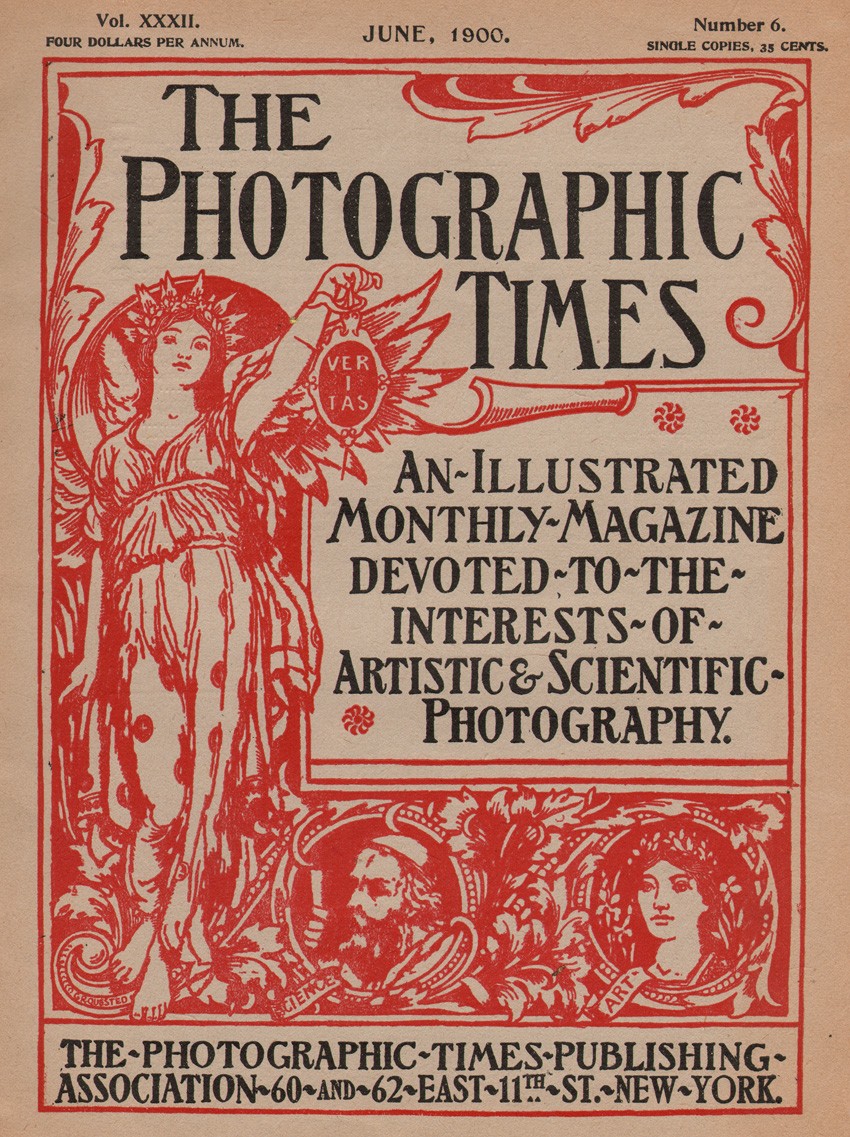 1895: The Veritas cover by Quested first used beginning in 1895 lasted through 1901, albeit in a smaller format that year. Printed in bold red ink, his design additionally featured inset portrait medallions of Science, represented by a bearded gentleman, and Art, by a fair maiden crowned by laurels. The previous weekly cover had stated: "A weekly journal devoted to the art, science and advancement of Photography" and the new monthly stated: "An illustrated monthly magazine devoted to the interests of Artistic & Scientific Photography." Sizes for cover- 1895-1900: (detail here eliminating part of borders) 29.3 x 22.5 cm; 1901: 25.0 x 17.5 cm. Cover, June, 1900: PhotoSeed Archive
1895: The Veritas cover by Quested first used beginning in 1895 lasted through 1901, albeit in a smaller format that year. Printed in bold red ink, his design additionally featured inset portrait medallions of Science, represented by a bearded gentleman, and Art, by a fair maiden crowned by laurels. The previous weekly cover had stated: "A weekly journal devoted to the art, science and advancement of Photography" and the new monthly stated: "An illustrated monthly magazine devoted to the interests of Artistic & Scientific Photography." Sizes for cover- 1895-1900: (detail here eliminating part of borders) 29.3 x 22.5 cm; 1901: 25.0 x 17.5 cm. Cover, June, 1900: PhotoSeed Archive
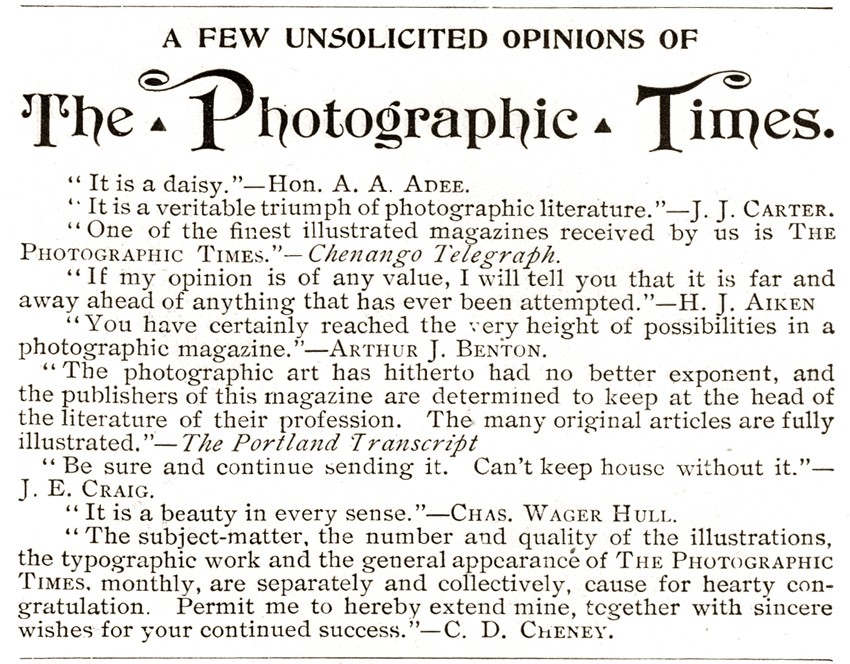 1896: Over-the-top reviews appeared frequently in various publications published by the Scovill & Adams firm in praise of the Times. One very widely-circulated volume for these praises was their annual published since 1887 titled “The American Annual of Photography and Photographic Times Almanac”, a compendium that had attained a circulation of over 20,000 copies by 1894. This advertisement of "unsolicited opinions" appeared in the advertising section of the 1896 annual. From: PhotoSeed Archive
1896: Over-the-top reviews appeared frequently in various publications published by the Scovill & Adams firm in praise of the Times. One very widely-circulated volume for these praises was their annual published since 1887 titled “The American Annual of Photography and Photographic Times Almanac”, a compendium that had attained a circulation of over 20,000 copies by 1894. This advertisement of "unsolicited opinions" appeared in the advertising section of the 1896 annual. From: PhotoSeed Archive
 1896 | 2012: As stated early in this post, the Scovill company, known since 1889 as Scovill & Adams, moved many times on the island of Manhattan. In 1896, they vacated their headquarters at 423 Broome street and took occupancy of a brand new, seven-story building specifically built for the company off of Broadway at 60 and 62 East Eleventh Street. Seen in this artist's drawing at left published in the January, 1896 issue of the Times, the editors said: "Our New Offices will be in the same building. The editorial rooms and offices will be situated on the main floor of the building. A very complete photographic and reference library will be conveniently arranged in the editorial rooms, and on the roof will be erected a finely fitted up dark-room and skylight gallery. These will be at the disposal of all our subscribers and friends." Scovill would stay in the building until the Fall of 1900. The building, housing the company Bijan Royal Inc. on the ground floor, can be seen today at right photographed in June, 2012. PhotoSeed Archive, left; right: photograph by David Spencer
1896 | 2012: As stated early in this post, the Scovill company, known since 1889 as Scovill & Adams, moved many times on the island of Manhattan. In 1896, they vacated their headquarters at 423 Broome street and took occupancy of a brand new, seven-story building specifically built for the company off of Broadway at 60 and 62 East Eleventh Street. Seen in this artist's drawing at left published in the January, 1896 issue of the Times, the editors said: "Our New Offices will be in the same building. The editorial rooms and offices will be situated on the main floor of the building. A very complete photographic and reference library will be conveniently arranged in the editorial rooms, and on the roof will be erected a finely fitted up dark-room and skylight gallery. These will be at the disposal of all our subscribers and friends." Scovill would stay in the building until the Fall of 1900. The building, housing the company Bijan Royal Inc. on the ground floor, can be seen today at right photographed in June, 2012. PhotoSeed Archive, left; right: photograph by David Spencer
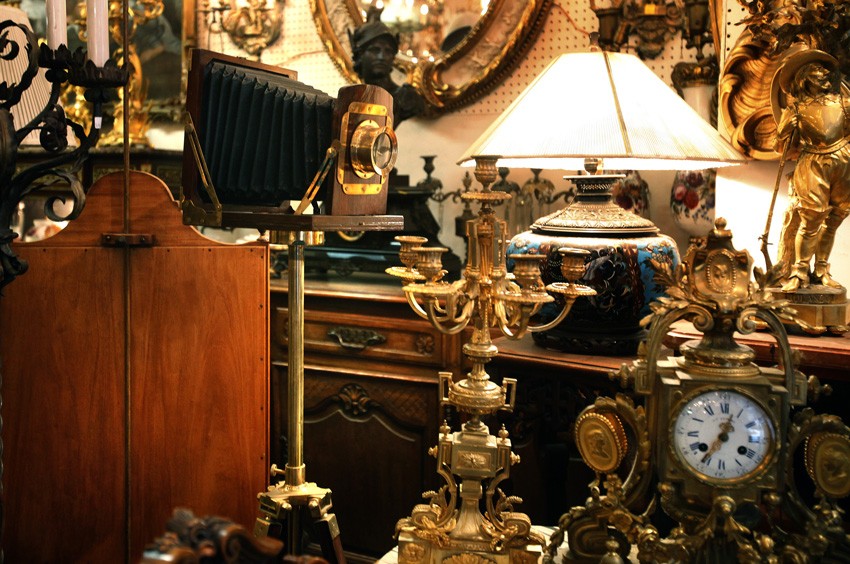 2012: More serendipity in the modern day or crazy fluke? A visit to the current first floor showroom space of antique dealer Bijan Royal at 60 East 11th street in June miraculously revealed on display this impressive looking, tripod-mounted plate camera. Quizzing a salesman produced no more details of its history however. Instead, he was keen on photo-copying the 1896 artist drawing of the building I showed him earlier while explaining my mission. Scovill & Adams in their day here made millions of dollars selling cameras like this one (even though it suspiciously appeared more ornamental than functional) as well as every conceivable photographic accessory known to man. For this space in its day formerly held one of the greatest photographic stock houses on the planet-with the Photographic Times offices in this space producing monthly the physical embodiment of the day's most important social media. PhotoSeed Archive photo by David Spencer
2012: More serendipity in the modern day or crazy fluke? A visit to the current first floor showroom space of antique dealer Bijan Royal at 60 East 11th street in June miraculously revealed on display this impressive looking, tripod-mounted plate camera. Quizzing a salesman produced no more details of its history however. Instead, he was keen on photo-copying the 1896 artist drawing of the building I showed him earlier while explaining my mission. Scovill & Adams in their day here made millions of dollars selling cameras like this one (even though it suspiciously appeared more ornamental than functional) as well as every conceivable photographic accessory known to man. For this space in its day formerly held one of the greatest photographic stock houses on the planet-with the Photographic Times offices in this space producing monthly the physical embodiment of the day's most important social media. PhotoSeed Archive photo by David Spencer
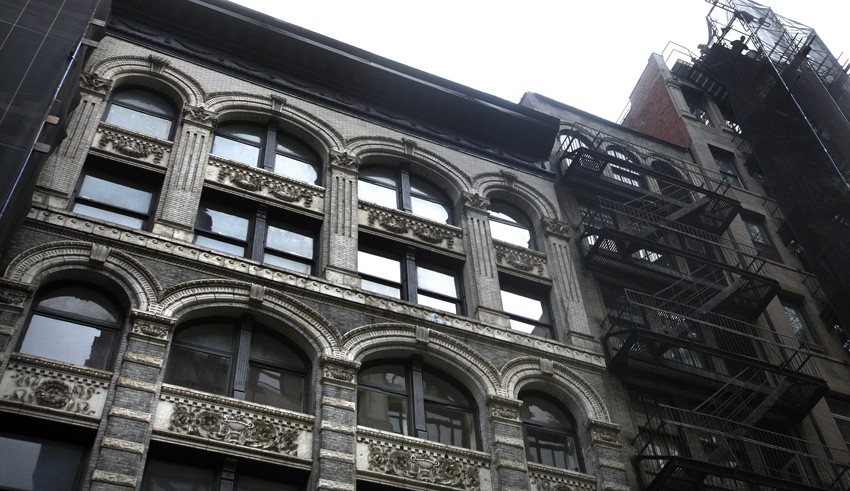 2012: A view of the facade showing the top floors of 60-62 East 11th. "The lofts will be reserved for the storage of original cases and other unpacked goods. A specially constructed dark-room for the use of their patrons and friends will be conveniently situated, and on the roof of the building there will be a commodious skylight, with light facing north, for experimental and testing purposes." During my visit, I tried my best to talk my way up to the top floor of the building to see if the skylight still existed, but to no avail. A quick search on the web indicates creative folks inhabit the seventh floor: music agency Crush Talent Management- so hooray for that. PhotoSeed Archive photo by David Spencer
2012: A view of the facade showing the top floors of 60-62 East 11th. "The lofts will be reserved for the storage of original cases and other unpacked goods. A specially constructed dark-room for the use of their patrons and friends will be conveniently situated, and on the roof of the building there will be a commodious skylight, with light facing north, for experimental and testing purposes." During my visit, I tried my best to talk my way up to the top floor of the building to see if the skylight still existed, but to no avail. A quick search on the web indicates creative folks inhabit the seventh floor: music agency Crush Talent Management- so hooray for that. PhotoSeed Archive photo by David Spencer
 1897: This extremely rare lithographic Photographic Times poster held and conserved by the Library of Congress in Washington D.C. was described in the April issue of the journal as follows: "We have had prepared for us a very attractive poster in seven colors. We give a half-tone reproduction of it herewith. Photographic dealers and newsagents will find this a valuable aid in obtaining subscriptions for this magazine. We will send one free on application and a promise that the same will be prominently displayed. The size of the poster is about 2x3 feet." Poster: Library of Congress
1897: This extremely rare lithographic Photographic Times poster held and conserved by the Library of Congress in Washington D.C. was described in the April issue of the journal as follows: "We have had prepared for us a very attractive poster in seven colors. We give a half-tone reproduction of it herewith. Photographic dealers and newsagents will find this a valuable aid in obtaining subscriptions for this magazine. We will send one free on application and a promise that the same will be prominently displayed. The size of the poster is about 2x3 feet." Poster: Library of Congress
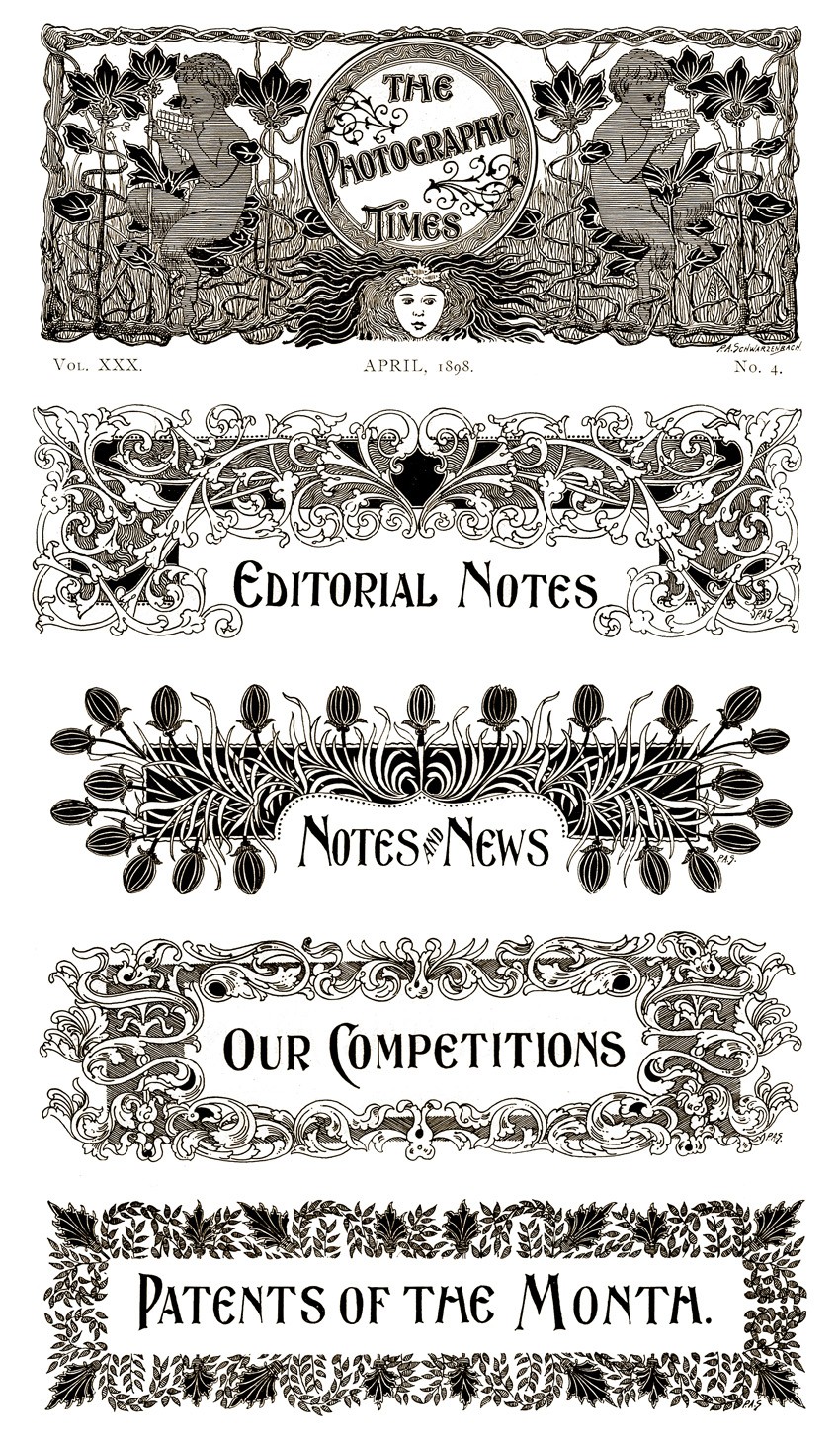 1898: In keeping with the spirit of the re-designed monthly after 1895- a "64-page artistic and scientific magazine of the very highest order" in the words of Times advertising copy from the period- illustrator P.A. Schwarzenbach supplied these decorative, Art-Nouveau inspired woodcut designs used to delineate the various departments within the editorial copy section of the journal. These specific floral designs were used during 1898 (and some before) and later into the new century. Additional Schwarzenbach designs appearing later included "Our Monthly Digest" and "The Editor's Table". Various designs, enhanced for clarity, with each approximately 6.5 x 15.5 cm ( +/-) from: PhotoSeed Archive
1898: In keeping with the spirit of the re-designed monthly after 1895- a "64-page artistic and scientific magazine of the very highest order" in the words of Times advertising copy from the period- illustrator P.A. Schwarzenbach supplied these decorative, Art-Nouveau inspired woodcut designs used to delineate the various departments within the editorial copy section of the journal. These specific floral designs were used during 1898 (and some before) and later into the new century. Additional Schwarzenbach designs appearing later included "Our Monthly Digest" and "The Editor's Table". Various designs, enhanced for clarity, with each approximately 6.5 x 15.5 cm ( +/-) from: PhotoSeed Archive
 1900: A few thoughts on Times editorial and advertising matter having to do with race. Going through old issues from the late 19th and early 20th century, I've run into that proverbial "elephant in the room" on more than one occasion: unflattering depictions of African-Americans, typically children. Through word and image, there is plenty of reason to believe this usage was not limited to mass-market American photographic journals but extended to many imprints of the era. One case in point seen here. Through modern eyes, a Times page designer going for the cheap laugh in representing monetary decision making and its potential outcomes for the amateur photographer for an article on the conundrum of photography being an affordable hobby used a series of vignettes of children stripped along the top and bottom of a page. These expressive "studies in black… and white" conveniently featured skin colors of the opposite hue for the January, 1896 article "It Costs Too Much". A mild example perhaps but one that made me wince when I first came across it. On the other hand, photographic depictions of African-Americans showing merit and historical importance do show up in the pages of the Times-even when done in the period genre style favored by American Rudolph Eickemeyer, Jr. At right, a fine example: a full-page halftone study of an elderly former slave titled "Thoughts of Other Days" from the October, 1900 issue- itself an advertisement for his book "Down South" published that year. Dimensions for "Thoughts": 22.5 x 17.7 cm. Both images: PhotoSeed Archive
1900: A few thoughts on Times editorial and advertising matter having to do with race. Going through old issues from the late 19th and early 20th century, I've run into that proverbial "elephant in the room" on more than one occasion: unflattering depictions of African-Americans, typically children. Through word and image, there is plenty of reason to believe this usage was not limited to mass-market American photographic journals but extended to many imprints of the era. One case in point seen here. Through modern eyes, a Times page designer going for the cheap laugh in representing monetary decision making and its potential outcomes for the amateur photographer for an article on the conundrum of photography being an affordable hobby used a series of vignettes of children stripped along the top and bottom of a page. These expressive "studies in black… and white" conveniently featured skin colors of the opposite hue for the January, 1896 article "It Costs Too Much". A mild example perhaps but one that made me wince when I first came across it. On the other hand, photographic depictions of African-Americans showing merit and historical importance do show up in the pages of the Times-even when done in the period genre style favored by American Rudolph Eickemeyer, Jr. At right, a fine example: a full-page halftone study of an elderly former slave titled "Thoughts of Other Days" from the October, 1900 issue- itself an advertisement for his book "Down South" published that year. Dimensions for "Thoughts": 22.5 x 17.7 cm. Both images: PhotoSeed Archive
 1900-1902 | 2012: From the Fall of 1900 to May, 1902, some of the executive offices of the Scovill & Adams Company were behind this now unused door at 3 West 19th street, just around the corner from Fifth Avenue. A September, 1900 account in the Times said: "The Fifth Avenue number of the building is 142, and the entrance to the executive offices of the Scovill & Adams Co. of New York, is No. 3 and 5 West 19th Street. The business will be divided in Sectional Department, Wholesale Department, Publication Department, and Sample Room. The last will be a feature that will appeal to out-of-town buyers, who have a limited time to spend in New York and must necessarily inspect, in a short time, everything that is new in the photographic line." PhotoSeed Archive photo by David Spencer
1900-1902 | 2012: From the Fall of 1900 to May, 1902, some of the executive offices of the Scovill & Adams Company were behind this now unused door at 3 West 19th street, just around the corner from Fifth Avenue. A September, 1900 account in the Times said: "The Fifth Avenue number of the building is 142, and the entrance to the executive offices of the Scovill & Adams Co. of New York, is No. 3 and 5 West 19th Street. The business will be divided in Sectional Department, Wholesale Department, Publication Department, and Sample Room. The last will be a feature that will appeal to out-of-town buyers, who have a limited time to spend in New York and must necessarily inspect, in a short time, everything that is new in the photographic line." PhotoSeed Archive photo by David Spencer
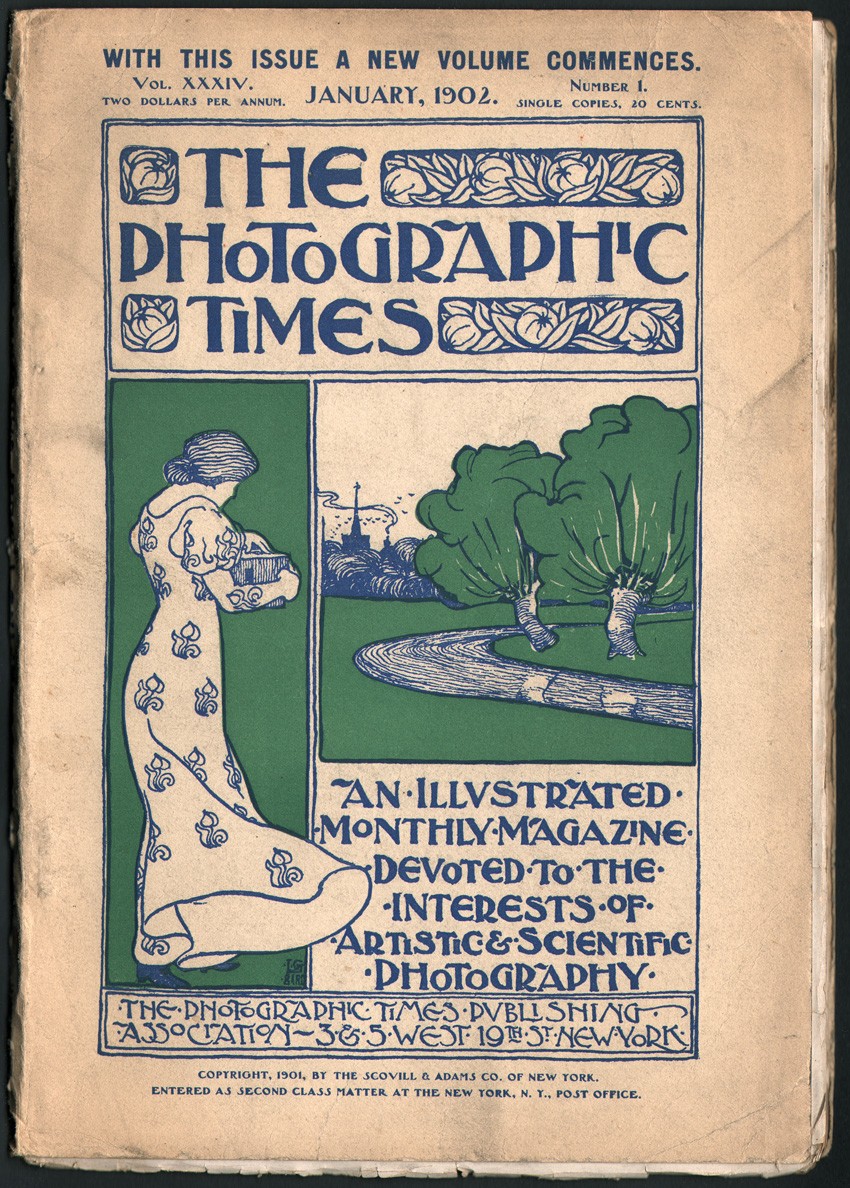 1902: A new cover design was introduced for The Photographic Times beginning with this issue in January, 1902. English artist Lennox G. Bird, who went by the professional moniker Curlew, (a playful association with his last name) had entered and won the Photographic Times silver medal competition the previous year. This design was used through at least January, 1903. Cover dimensions: 25.2 x 17.5 cm Cover: PhotoSeed Archive
1902: A new cover design was introduced for The Photographic Times beginning with this issue in January, 1902. English artist Lennox G. Bird, who went by the professional moniker Curlew, (a playful association with his last name) had entered and won the Photographic Times silver medal competition the previous year. This design was used through at least January, 1903. Cover dimensions: 25.2 x 17.5 cm Cover: PhotoSeed Archive
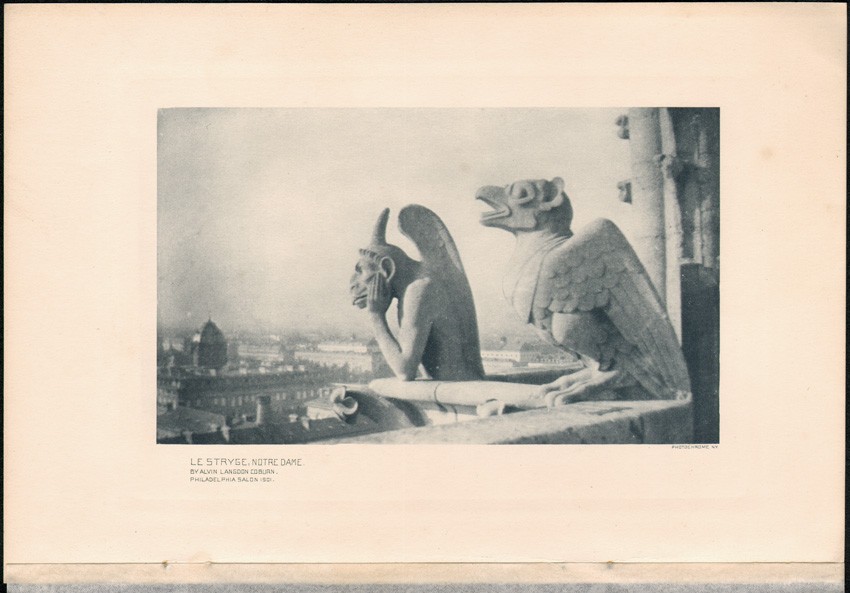 1902: Tissue-protected, hand-pulled photogravures like this example by American and later Welsh photographer Alvin Langdon Coburn (1882-1966) titled "Le Stryge; Notre Dame", continued to be featured in the Photographic Times, albeit in the smaller format beginning with the January, 1901 issue. Printed by the Photochrome Engraving Company of New York City, Coburn's photograph features two gargoyles watching over the city of Paris from a tower parapet of the Cathedral of Notre Dame. The image was inspired by French artist Charles Méryon's (1821-1868) 1853 etching of the gargoyle at center titled Le Stryge. (The Vampire) Plate dimensions: image: 10.0 x 16.4 cm | support:17.1 x 24.9 cm from: PhotoSeed Archive
1902: Tissue-protected, hand-pulled photogravures like this example by American and later Welsh photographer Alvin Langdon Coburn (1882-1966) titled "Le Stryge; Notre Dame", continued to be featured in the Photographic Times, albeit in the smaller format beginning with the January, 1901 issue. Printed by the Photochrome Engraving Company of New York City, Coburn's photograph features two gargoyles watching over the city of Paris from a tower parapet of the Cathedral of Notre Dame. The image was inspired by French artist Charles Méryon's (1821-1868) 1853 etching of the gargoyle at center titled Le Stryge. (The Vampire) Plate dimensions: image: 10.0 x 16.4 cm | support:17.1 x 24.9 cm from: PhotoSeed Archive
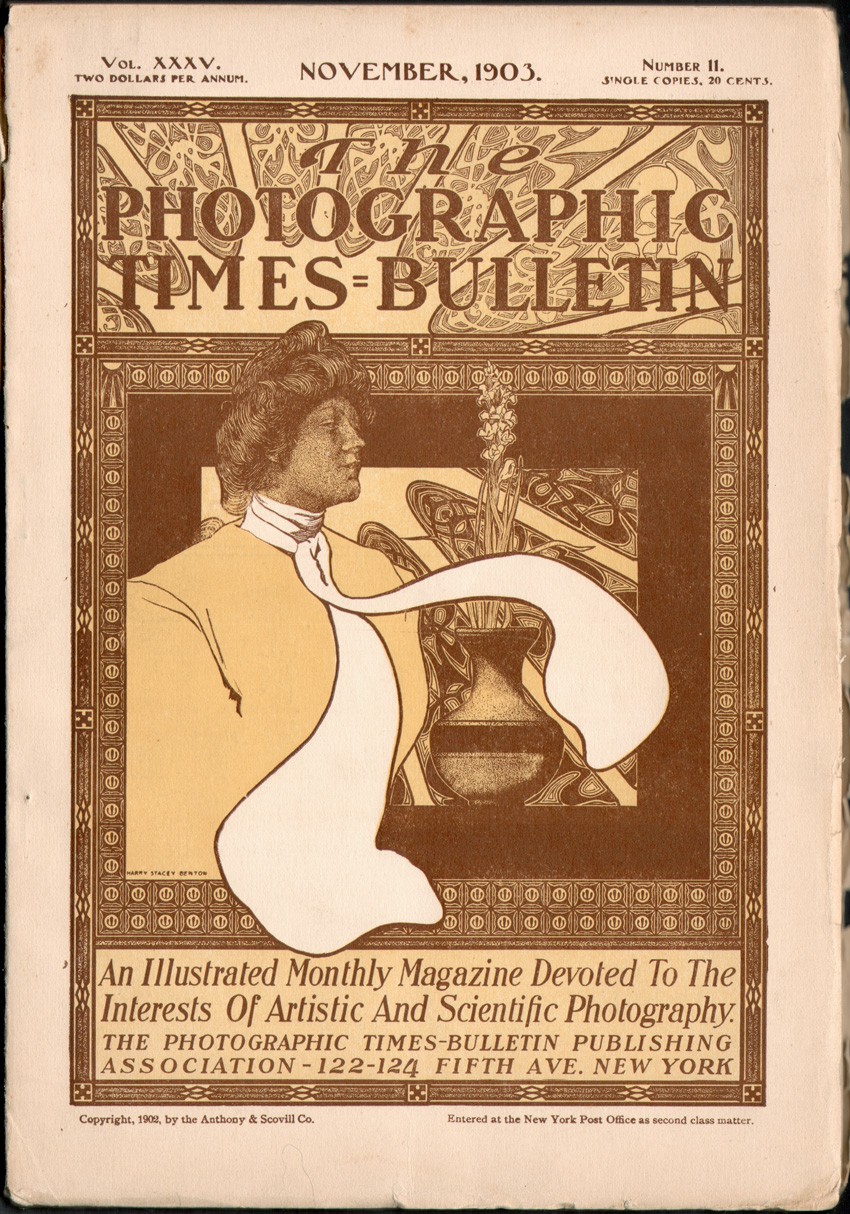 1902-1904: Beginning with the April, 1902 issue, the Photographic Times was renamed The Photographic Times-Bulletin, a combining of the Photographic Times and Anthony’s Photographic Bulletin, itself a result of the blockbuster December, 1901 business deal in which Scovill & Adams joined forces with the E. & H. T. Anthony & Company in order to fight off the mighty Kodak. Lennox G. Bird's cover design from 1902 carried over to the new publication until at least January, 1903, when this design by Chicago illustrator Harry Stacey Benton (b. 1876 or 1878) was used, most likely with the February issue. This was the final cover design for the Times-Bulletin which ceased publication under this name after the December, 1904 issue-reverting back to The Photographic Times in 1905. The wood-engraved, Art-Nouveau portrait of a woman with vase of flowers is set within an elaborate ornamental frame and printed in two colors. Cover dimensions: 25.2 x 17.5 cm. From: PhotoSeed Archive
1902-1904: Beginning with the April, 1902 issue, the Photographic Times was renamed The Photographic Times-Bulletin, a combining of the Photographic Times and Anthony’s Photographic Bulletin, itself a result of the blockbuster December, 1901 business deal in which Scovill & Adams joined forces with the E. & H. T. Anthony & Company in order to fight off the mighty Kodak. Lennox G. Bird's cover design from 1902 carried over to the new publication until at least January, 1903, when this design by Chicago illustrator Harry Stacey Benton (b. 1876 or 1878) was used, most likely with the February issue. This was the final cover design for the Times-Bulletin which ceased publication under this name after the December, 1904 issue-reverting back to The Photographic Times in 1905. The wood-engraved, Art-Nouveau portrait of a woman with vase of flowers is set within an elaborate ornamental frame and printed in two colors. Cover dimensions: 25.2 x 17.5 cm. From: PhotoSeed Archive
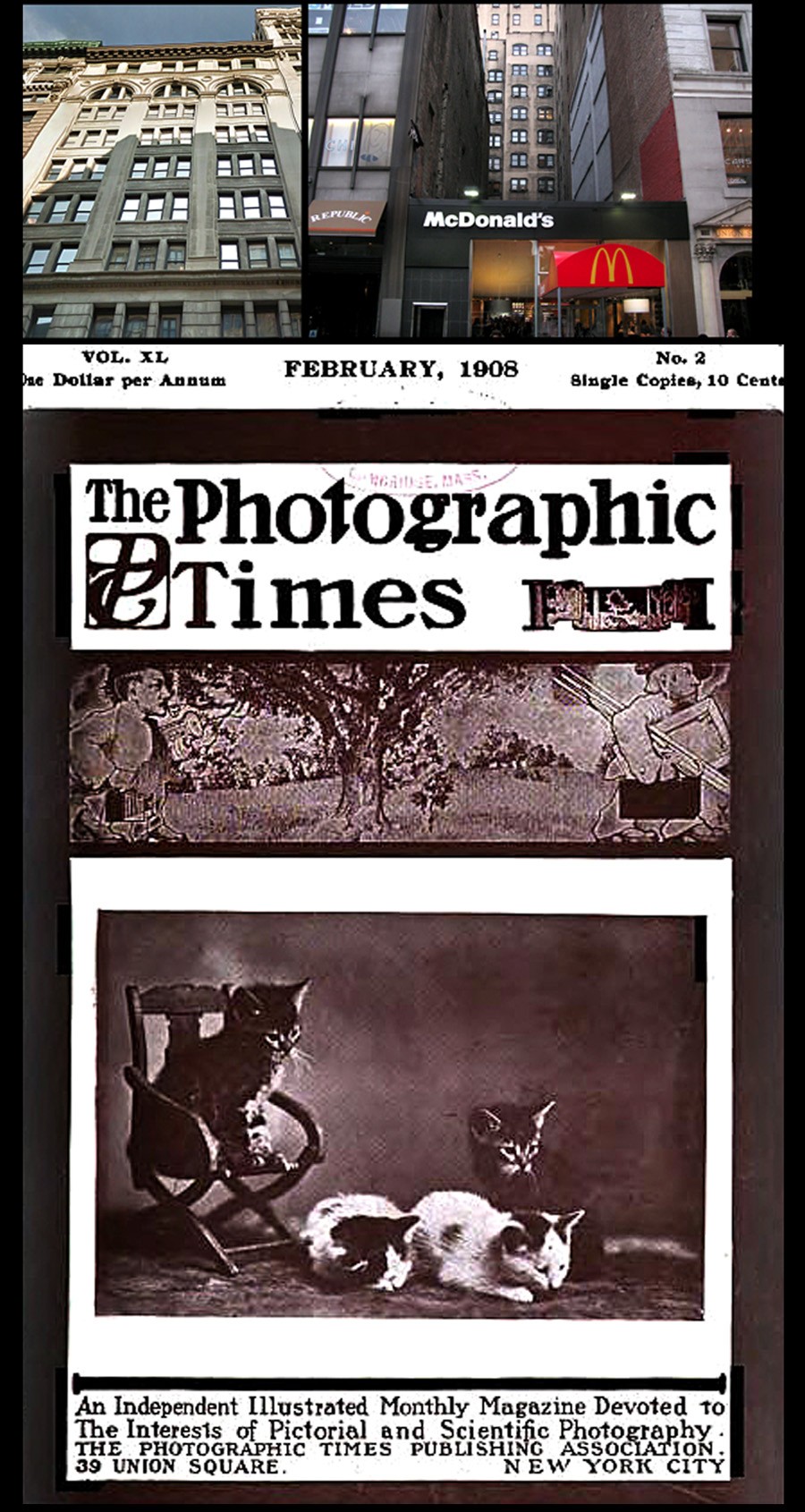 1902-1903 | 1904 | 1904-1908: Three address and two ownership changes took place for the Times-Bulletin and Photographic Times between 1902-1908. Upper left photo: from 1902-1903, the Times-Bulletin was published from this ornate building at 122-124 Fifth Ave.; the home of the combined firm of the Anthony & Scovill Company. By April of 1904, Lincoln Adams had bought out Anthony & Scovill's controlling interest in the journal, retaining the journal's name through the end of the year and moving the offices to Styles & Cash Printers at 75-77 Eighth Ave., a company he was president of. (this building no longer stands and is now occupied by an ornate bank building now turned into luxury condos) Upper right photo: from December, 1904 through 1908, the renamed Photographic Times (January, 1905) was published in a building that also no longer stands at 39 Union Square West, now the location of a McDonald's restaurant. Bottom cover: This is a representative cover of the Times from the Union Square years. Now priced at 10 cents, or a dollar a year, it featured a whimsical caricature of a photographer with camera in hand following an artist who holds his canvas and easel in pursuit of the next great vista anchored below the journal masthead. The February, 1908 cover art featured a large halftone photograph of decidedly "light" subject matter: a grouping of kittens. Reflecting this decidedly saccharine mass-market appeal, the Times guiding principal at bottom of cover also had changed to: "An Independent Illustrated Monthly Magazine Devoted to The Interests of Pictorial and Scientific Photography." Photo credits: Anthony & Scovill: Google Street View; Union Square: David Spencer/PhotoSeed Archive, cover: HathiTrust
1902-1903 | 1904 | 1904-1908: Three address and two ownership changes took place for the Times-Bulletin and Photographic Times between 1902-1908. Upper left photo: from 1902-1903, the Times-Bulletin was published from this ornate building at 122-124 Fifth Ave.; the home of the combined firm of the Anthony & Scovill Company. By April of 1904, Lincoln Adams had bought out Anthony & Scovill's controlling interest in the journal, retaining the journal's name through the end of the year and moving the offices to Styles & Cash Printers at 75-77 Eighth Ave., a company he was president of. (this building no longer stands and is now occupied by an ornate bank building now turned into luxury condos) Upper right photo: from December, 1904 through 1908, the renamed Photographic Times (January, 1905) was published in a building that also no longer stands at 39 Union Square West, now the location of a McDonald's restaurant. Bottom cover: This is a representative cover of the Times from the Union Square years. Now priced at 10 cents, or a dollar a year, it featured a whimsical caricature of a photographer with camera in hand following an artist who holds his canvas and easel in pursuit of the next great vista anchored below the journal masthead. The February, 1908 cover art featured a large halftone photograph of decidedly "light" subject matter: a grouping of kittens. Reflecting this decidedly saccharine mass-market appeal, the Times guiding principal at bottom of cover also had changed to: "An Independent Illustrated Monthly Magazine Devoted to The Interests of Pictorial and Scientific Photography." Photo credits: Anthony & Scovill: Google Street View; Union Square: David Spencer/PhotoSeed Archive, cover: HathiTrust
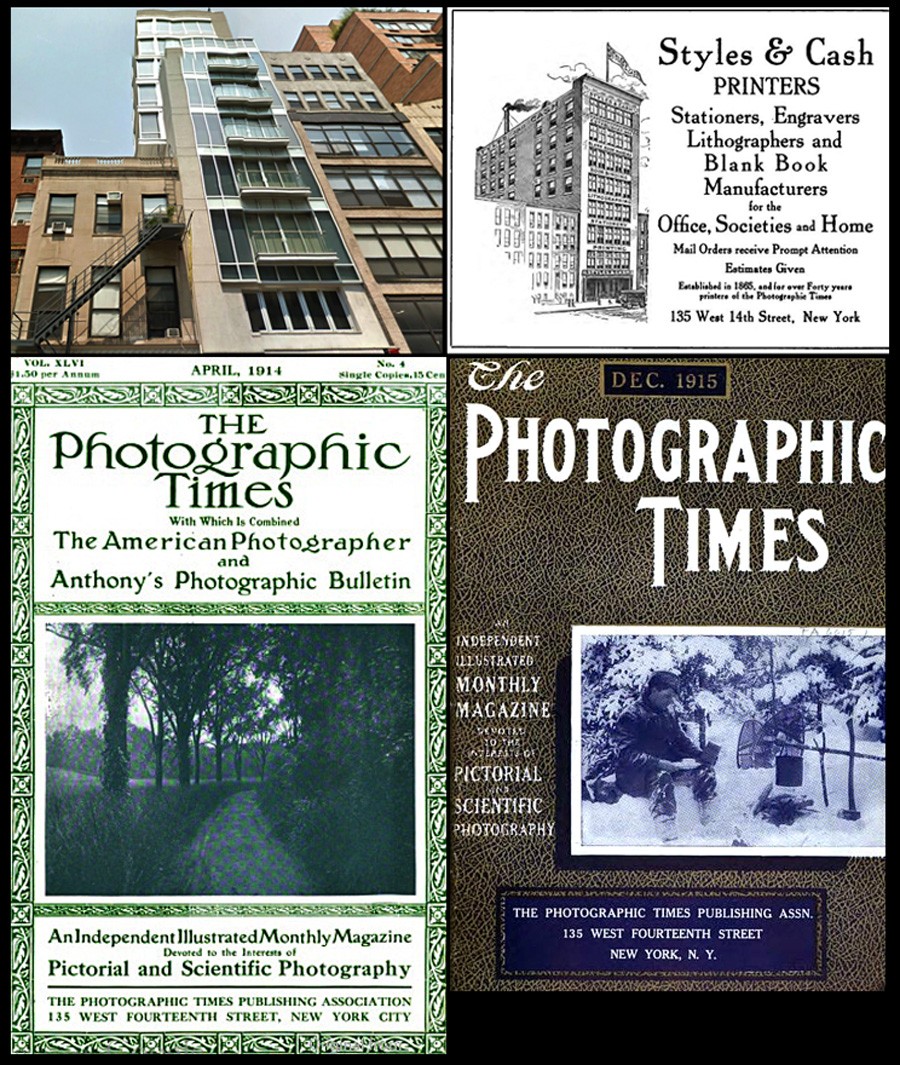 1909-1915: Under The Photographic Times Publishing Association, the Times was edited and published the final six years from this building at 135 West 14th street at top left: a ten-story building erected in 1906 by architect Charles Birge for the printing firm Styles & Cash. Since remade (2004) into condos on the upper floors with a hair salon at street level, a December, 1915 advertisement in the Times for the company is at top right. Two other cover design changes for the journal took place during this period. At lower left is the issue from April, 1914 and at lower right, the final cover for the December, 1915 issue. The Styles & Cash firm was in operation in New York from 1865-1920. Photo credits: Styles & Cash: Google Street View; ad & covers: HathiTrust
1909-1915: Under The Photographic Times Publishing Association, the Times was edited and published the final six years from this building at 135 West 14th street at top left: a ten-story building erected in 1906 by architect Charles Birge for the printing firm Styles & Cash. Since remade (2004) into condos on the upper floors with a hair salon at street level, a December, 1915 advertisement in the Times for the company is at top right. Two other cover design changes for the journal took place during this period. At lower left is the issue from April, 1914 and at lower right, the final cover for the December, 1915 issue. The Styles & Cash firm was in operation in New York from 1865-1920. Photo credits: Styles & Cash: Google Street View; ad & covers: HathiTrust
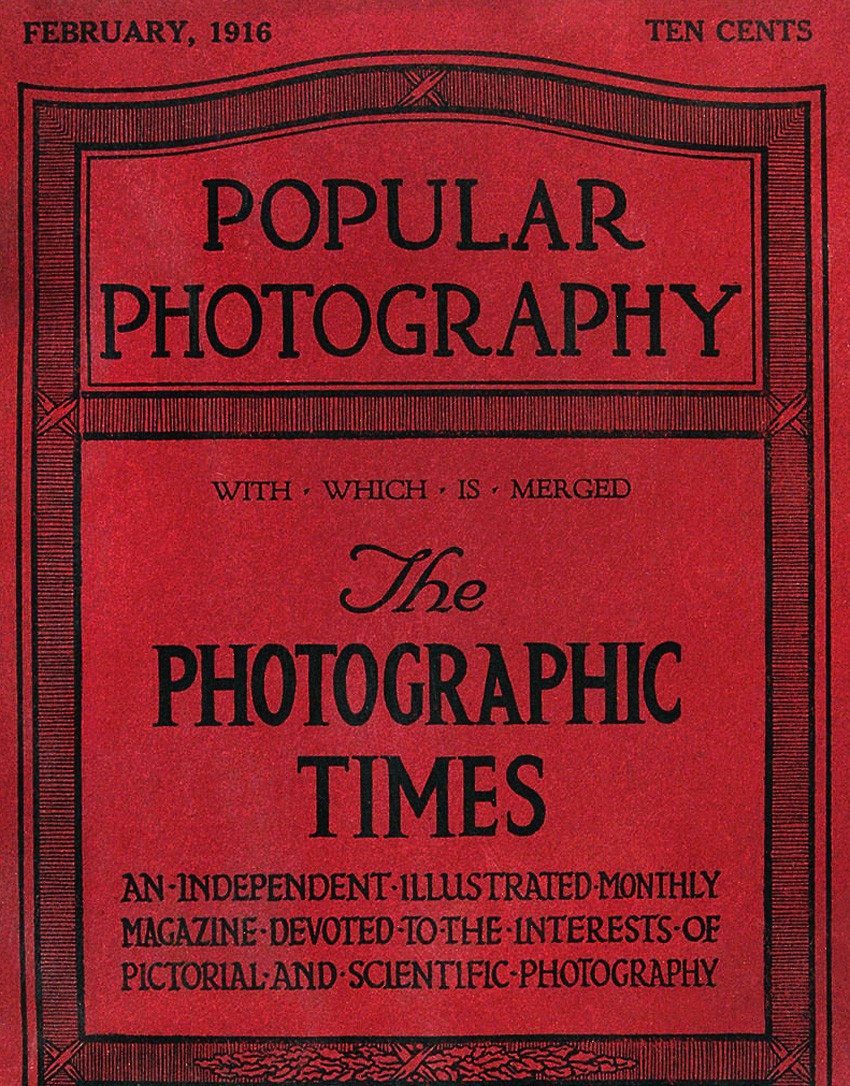 1916: With Which Is Merged: Beginning with the January, 1916 issue, the Times masthead was gone for good: absorbed into Popular Photography, a new journal published in Boston since October, 1912. Edited by Frank Roy Fraprie, W. I. Lincoln Adams was retained as an associate editor, although it is doubtful he had much of a hand with its affairs. Cover detail: February, 1916: Ebay
1916: With Which Is Merged: Beginning with the January, 1916 issue, the Times masthead was gone for good: absorbed into Popular Photography, a new journal published in Boston since October, 1912. Edited by Frank Roy Fraprie, W. I. Lincoln Adams was retained as an associate editor, although it is doubtful he had much of a hand with its affairs. Cover detail: February, 1916: Ebay
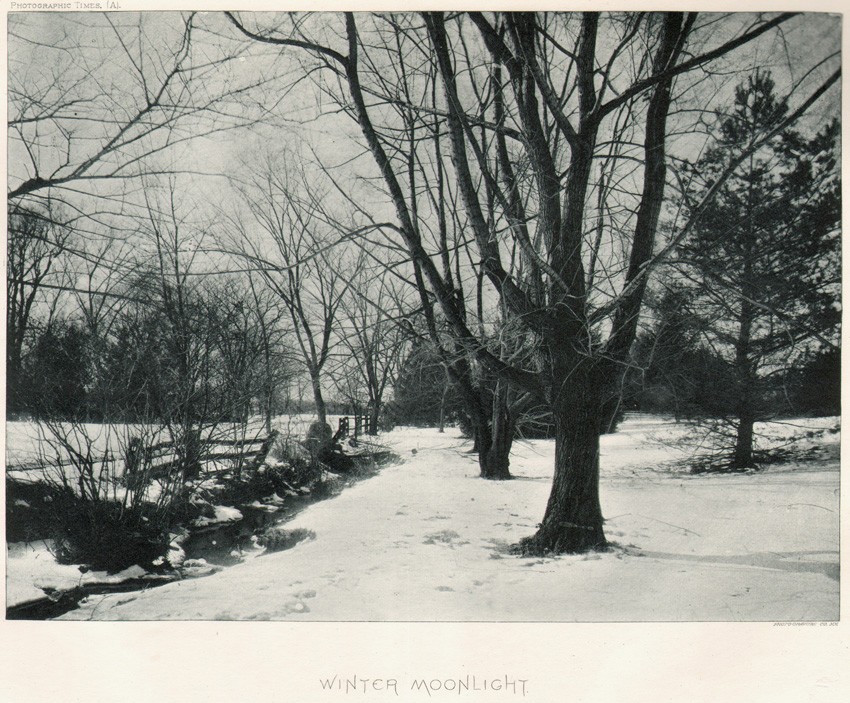 The Photographic Times was a labor of love for a father and son. Washington Irving Adams had the spark and drive to get the journal up and running beginning in 1870 and son W. I. Lincoln Adams dutifully took over the reigns of not only the journal but the Scovill & Adams firm upon his father's passing. In my view, the legacy they left in the form of the journal is invaluable, with their efforts along with many others giving enjoyment and continuing instruction on the art and science of photography from 1871-1915 we should continue to appreciate and investigate. This landscape study "Winter Moonlight" by Lincoln Adams was taken around 1885 and published in the Times in 1890. It is not especially memorable in my view, but does contain the kernel of adventure all photography has: "Let the landscape loving photographer of this city and neighborhood take a ramble with his camera" the Times copywriter (possibly Adams himself) declared as inspiration taken from the scene of this snow-blanketed wooded glade. Continuing the thought, "Mr. Adams is always eager to conduct a party, large or small, to the beautiful haunts about his picturesque home." As a young photographer myself, this was just the type of place I took my own camera to in search of what photography could accomplish and mean while learning most about my own self. My hunch is Adams own tramps in places like this shaped his thinking and outlook as well. Image: 14.4 x 19.7 cm | support: 20.5 x 28.7 cm. : photogravure in The Photographic Times, February 7, 1890 | issue No. 438: From: PhotoSeed Archive
The Photographic Times was a labor of love for a father and son. Washington Irving Adams had the spark and drive to get the journal up and running beginning in 1870 and son W. I. Lincoln Adams dutifully took over the reigns of not only the journal but the Scovill & Adams firm upon his father's passing. In my view, the legacy they left in the form of the journal is invaluable, with their efforts along with many others giving enjoyment and continuing instruction on the art and science of photography from 1871-1915 we should continue to appreciate and investigate. This landscape study "Winter Moonlight" by Lincoln Adams was taken around 1885 and published in the Times in 1890. It is not especially memorable in my view, but does contain the kernel of adventure all photography has: "Let the landscape loving photographer of this city and neighborhood take a ramble with his camera" the Times copywriter (possibly Adams himself) declared as inspiration taken from the scene of this snow-blanketed wooded glade. Continuing the thought, "Mr. Adams is always eager to conduct a party, large or small, to the beautiful haunts about his picturesque home." As a young photographer myself, this was just the type of place I took my own camera to in search of what photography could accomplish and mean while learning most about my own self. My hunch is Adams own tramps in places like this shaped his thinking and outlook as well. Image: 14.4 x 19.7 cm | support: 20.5 x 28.7 cm. : photogravure in The Photographic Times, February 7, 1890 | issue No. 438: From: PhotoSeed Archive
This entry was posted on Sunday, November 25th, 2012 at 9:00pm and is filed under Advertising, History of Photography, Journals, Publishing. You can follow any responses to this entry through the RSS 2.0 feed.